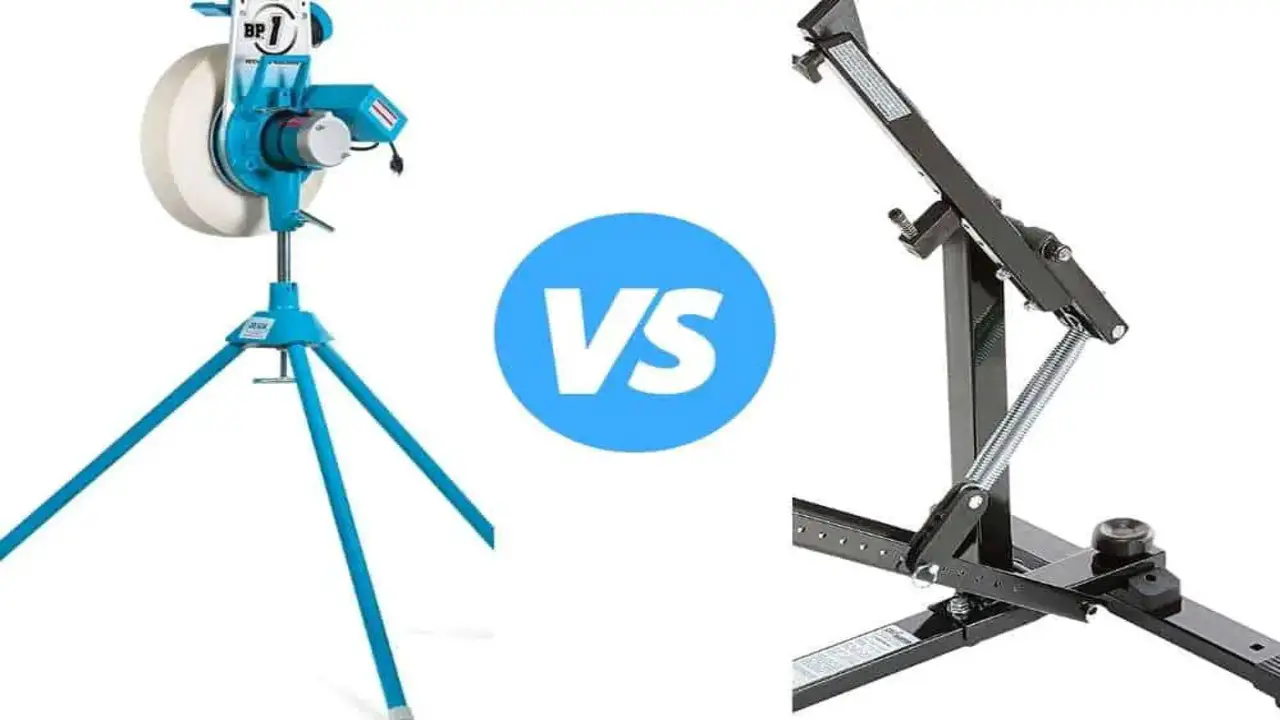Are you curious about how a pitching machine works? Pitching machines are used in many sports, such as baseball and softball, to simulate a pitcher’s throwing motion. Using a combination of mechanical and electronic components, pitching machines can accurately and consistently throw a variety of pitches.
In this article, we’ll explore how a pitching machine works and how it can help improve athletes’ skills. By understanding the mechanics behind the machine, you can better appreciate its importance in sports training. So, read on to find out more about how a pitching machine works and how it can help you become a better player.

Understanding A Pitching Machine Work

Pitching machines are a popular tool used in baseball and softball practice. But how do they actually work? This article will discuss the various components of a pitching machine and how they contribute to its ability to accurately and consistently pitch a ball.
It will also cover various types of pitching machines and how they differ in terms of the type of pitch they deliver. Finally, it will discuss the advantages and disadvantages of using a pitching machine for practice and training. So if you’ve ever wanted to know more about how a pitching machine works and how it can help improve your game, then read on!
Components

A pitching machine is a device that throws a baseball or softball to a batter. It is usually used for batting practice in baseball and softball. Pitching machines use a variety of different components to function.
- The first component is the power source. This can be either electricity or a battery.
- The second component is the throwing arm. This is what actually throws the ball to the batter. It is usually made of metal and is powered by the power source.
- The third component is the control unit. This is what controls the speed and direction of the ball. It can be adjusted by the user to vary the speed and direction of the ball.
- The fourth component is the ball feeder. This is what feeds the ball to the throwing arm. It can be either manual or automatic.
- The fifth component is the ball return system. This is what returns the ball to the ball feeder after the ball has been thrown. It can either be manual or automatic.
These components all work together to form a pitching machine that can accurately and consistently throw pitches. It is a great tool for developing and improving batting skills.
Motor
A motor powers the pitching machine. It is an electric motor that turns a wheel connected to a belt, which in turn rotates the throwing arm. The motor is adjustable so the ball can be pitched at different speeds.
Control Panel
The Control Panel of a pitching machine is the part of the machine that allows you to adjust the speed, spin, and trajectory of the ball. This panel is typically located on the side or top of the machine and has a variety of knobs, buttons, and switches that let you control the machine. By adjusting the settings on the control panel, you can customize the pitch to your specific needs.
Pitching Mechanism
Pitching Mechanism is the process of throwing a baseball or softball with accuracy. It is a complex process that involves the use of various body parts, including the legs, hips, arms, and shoulders. A pitching machine is a device used to help a pitcher practice and improve their pitching accuracy.
It works by throwing balls at a predetermined speed and trajectory. The machine allows a pitcher to practice specific pitches and perfect their technique without the need for a catcher.
Power Source
The power source of the pitching machine is typically an electric motor. This motor is used to spin the wheels of the machine, which in turn propel the ball forward. The speed of the motor can be adjusted to control the speed of the pitch.
Operation

A pitching machine is a device used to propel a ball or other object at a high velocity with accuracy and precision. The machine is typically found in baseball and softball batting cages, as well as at indoor and outdoor practice areas.
It works by using a motor to turn a wheel or drum that is connected to a spring, which is then loaded with a ball or other object. When the wheel is turned, the spring is released, launching the object forward. The speed and accuracy of the pitch can be adjusted by adjusting the wheel speed, spring tension, or the angle of the launch.
Pitching machines are often used to simulate the speed and type of pitch thrown by a particular pitcher, allowing players to practice against the exact same type of ball they would face in a game. Pitching machines also allow coaches to build consistency among a team’s batting practices.
Pitching machines can be powered either by electricity or air pressure. Electric machines use a motor to turn the wheel, while air-powered machines use either a hand pump or a CO2 tank to generate the pressure needed to launch the ball. The type and size of the ball used in the machine will also affect the speed and accuracy of the pitch.
Pitching machines are an essential part of any baseball or softball player’s practice routine. Whether used for batting practice or to simulate game-like conditions, these machines are invaluable for honing accuracy and improving the player’s overall performance.
Load Balls
Loading balls into a pitching machine is a simple process. The user places the balls into a hopper, which is a large container. The balls then roll down a track into the throwing arm of the machine. The throwing arm then launches the ball at the desired speed and angle.
Adjust Settings
Adjusting the settings on a pitching machine is an important step in ensuring it works correctly. There are several settings that can be adjusted, including the speed of the pitch, the angle of the pitch, and the type of ball being used. By adjusting these settings, you can ensure that your pitching machine delivers consistent pitches with the desired speed and accuracy.
Activate Machine
Activating a pitching machine is relatively simple. Typically, a user can turn it on by pressing a power button or switch. Once powered, the machine can be set to a desired speed using a speed setting knob or dial.
In addition, users can adjust the angle of the pitch and the position of the machine to add more variety to the pitches. Finally, the user can press a button or switch to start the machine and begin pitching.
Pitch Ball
Pitch Ball is a sport that requires a pitching machine in order to throw the ball. The pitching machine works by using a motor to spin a wheel which propels the ball forward. The speed of the ball is determined by the speed of the motor and the angle of the wheel. The ball is then released from the wheel and thrown toward the batter.
Conclusion
A pitching machine is a device used to throw balls at a batter for practice. It works by using an electric motor to spin a wheel that propels the ball towards the batter. The speed and angle of the pitch is adjustable, allowing the batter to practice against different types of pitches. Pitching machines are used by baseball and softball teams to improve batting skills and accuracy.
FAQs
1.What Type Of Power Source Is Used To Operate A Pitching Machine?
Ans: A pitching machine is typically powered by electricity, either by plugging it in or using a battery. Some pitching machines may also be powered by compressed air or gas. Most pitching machines allow for the speed and type of pitch to be adjusted, as well as the angle of the machine. This allows for a wide range of drills and practice scenarios.
2.What Is The Average Speed Of A Pitch Thrown From A Pitching Machine?
Ans: The average speed of a pitch thrown from a pitching machine depends on the speed setting of the machine. Generally, pitching machines can throw pitches at speeds between 25 and 100 mph. The average speed of a pitch thrown from a pitching machine is usually around 40 to 50 mph. However, some machines are capable of throwing pitches at faster speeds.
3.How Often Should A Pitching Machine Be Serviced And Maintained?
Ans: A pitching machine should be serviced and maintained at least once a year. It is also advised to inspect the machine for any signs of damage or wear and tear before and after each use. The moving parts should be lubricated regularly to ensure proper functioning. It is important to contact an authorized professional for maintenance and servicing to keep the machine in good working condition.
4.What Is The Maximum Range Of A Pitching Machine?
Ans: The maximum range of a pitching machine depends on the type and model of the machine. Generally, most pitching machines can throw a ball up to around 300 feet. However, some higher end models can throw up to 500 feet or more. The exact range of a specific machine can be found in its product description.
5.Does A Pitching Machine Require Any Special Safety Features?
Ans: Yes, a pitching machine requires special safety features. This includes having protective nets or screens around the machine to prevent balls from flying out into a crowd. The machine should also be securely anchored to the ground to make sure it does not tip over. Additionally, the machine should be checked regularly for any wear and tear that could lead to a malfunction.

